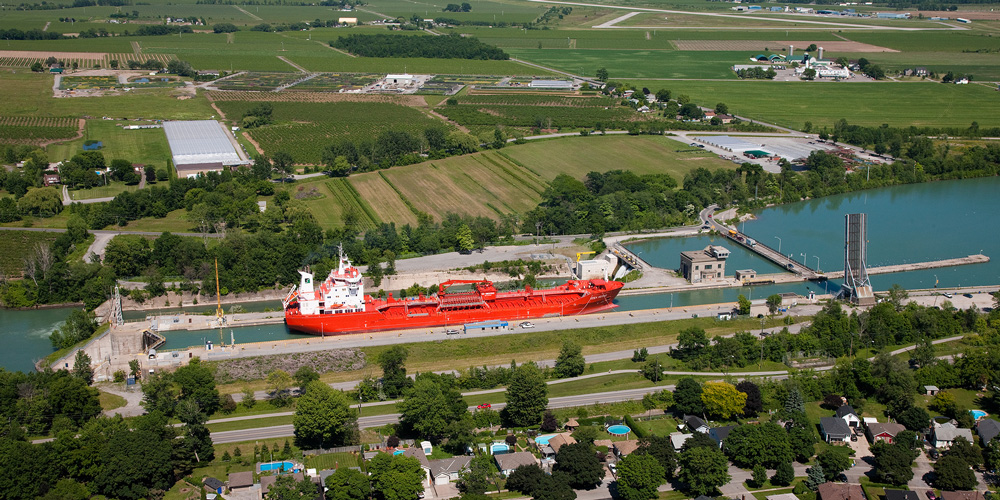#15 – Closing of the 2003 Navigation Season
November 25, 2003
The Seaway Corporations, as per the process outlined in Seaway Notice 13, have reviewed the climatic conditions and forecasts, as well as vessel demand for the closing period. While it is the Corporations’ intention to extend navigation to December 24th and beyond if conditions are favorable, the data available at this stage is inconclusive. The Corporation has, however, at this time agreed to waive the applicable surcharges for December 21st and 22nd, 2003.
Current and forecasted conditions will be reviewed in early December, and any further changes with regards to waiving of surcharges and closing dates will be communicated via Seaway Notices on or about December 8th and December 15th, 2003.
Irrespective of operating conditions, due to winter maintenance requirements in both sections of the Seaway, navigation will not be extended beyond December 29th at 2400 hours.
Mariners are reminded that there is always a possibility that severe climatic conditions may occur during the closing period. Should this happen, there is a chance that the dates outlined below, for the Welland Canal or the Montreal-Lake Ontario Section, may not be met.
Welland Canal
Mariners are advised that, at this time, the closing of the Welland Canal is scheduled to take place at 0800 hours on December 24. The final closing date and time will be announced no later than December 15, 2003 and any transits allowed beyond this date, depending on demand and operating conditions, will be subject to written agreements.
Montreal/Lake Ontario Section
Mariners are advised that the surcharges for December 21 and 22 have been waived. Demand and operating conditions permitting, the surcharges for December 23 and 24 may be waived. Should transits of the Montreal-Lake Ontario section be permitted after 2400 hours December 24th, they will be subject to prior written agreement.
Detailed Closing Procedures
For the 2003 navigation season, the Seaway entities have agreed to apply the closing procedures outlined below. In these procedures, the following definitions are used:
a) the closing period: the period beginning December 1 and continuing until the last ship has completed its transit;
b) given that surcharges have been waived for December 21 and 22, the clearance date is December 22, at 2400 hours.
During the closing period, the following procedures will be in effect:
1. Reporting
a. Commencing at 0001 hours, December 1 and for the duration of the closing period, each upbound ship entering the Seaway at CIP 2 or departing upbound from a port, dock, wharf or anchorage in the Montreal/Lake Ontario Section must declare the furthermost destination of its voyage.
b. Commencing at 0001 hours, December 17 and for the duration of the closing period, each downbound ship entering traffic control Sector 4 at mid-Lake Ontario must declare the furthermost St. Lawrence River destination of its voyage, along with all intermediate destinations.
Regarding a) and b) above, each ship must advise the nearest traffic control centre of any changes in these destinations.
2. Upbound Ships with Destinations above Port Colborne
a. A ship which enters the Seaway System upbound at CIP 2 after 2400 hours on December 9 and transits above Port Colborne shall be designated a ‘wintering ship‘.
b. A ‘wintering ship’ wishing to return downbound through the Montreal/Lake Ontario Section will be granted downbound transit privileges only if, in the opinion of the Manager and the Corporation, such transit can be accomplished safely and without interfering with the orderly and timely transit of any ship not designated as a ‘wintering ship‘ or without otherwise disrupting the system.
c. A ‘wintering ship‘ wishing to return downbound through the Montreal/Lake Ontario Section must give notification of such intent to the Manager or Corporation at least 48 hours prior to arriving at CIP 16 (Port Colborne).
d. If a ‘wintering ship‘ is granted downbound transit privileges through the Montreal/Lake Ontario Section, it will be subject to the following:
i. A ‘wintering ship‘ will yield, whenever required to do so by the Manager or the Corporation, its downbound order of turn at Port Colborne (CIP 16) and in the area from Cape Vincent to Prescott anchorage in favour of ships which are not designated as ‘wintering ship’.
ii. The application of sub-paragraph (i) above shall not excuse a ‘wintering ship‘ from liability for the post-clearance-date operational surcharges as specified in the St. Lawrence Seaway Tariff of Tolls.
e. A ‘wintering ship’ will be required to accept and acknowledge that a downbound transit is not assured, and that the Manager and the Corporation make no representation whatsoever as to their ability to successfully transit the ship downbound through the Montreal/Lake Ontario Section.
3. Acceptance for Transit through the Montreal/Lake Ontario Section
a. Upbound ships not otherwise restricted will be accepted for transit through the Montreal/Lake Ontario Section at Cap St. Michel up to 2400 hours, December 22.
b. Downbound ships not otherwise restricted will be accepted for transit through the Montreal/Lake Ontario Section at calling-in point Cape Vincent up to 2400 hours, December 22.
c. Ships, which have complied with these clearance dates call-in procedures, will be cleared through the system, operating conditions permitting. ‘Operating conditions‘ means all conditions that affect or may affect the operation and maintenance of the Montreal/Lake Ontario Section of the Seaway as determined by the Seaway entities.
d. Ships which report at the designated call-in points at Cap St. Michel and Cape Vincent after 2400 hours, December 22, will be allowed to transit only if, in the judgement of both Seaway entities, operating conditions permit. Such transit will be subject to the provisions of Paragraph 4 below.
i. Ships which are at a port, dock or wharf in the Cap St. Michel-Cape Vincent section of the Seaway and which report for transit after the clearance date will be allowed to transit only if, in the judgement of both Seaway entities, operating conditions permit.
Such transits will be subject to the surcharges as outlined in Paragraph 4 below, with the exception that, for ships which are at a port, dock or wharf within the St. Lambert-Iroquois Lock segment, the application of the surcharges will commence after 2400 hours, December 23.
ii. For ships included in the foregoing paragraph, the time and date that the ship reports to be ready in all respects to transit will be taken as the criteria for the establishment of the amount of surcharge.
e. In no event will any ship be accepted for transit through the Montreal/Lake Ontario Section of the Seaway after 2400 hours, December 24, unless it has reached a prior written agreement as to approval of such transit with both the Manager and the Corporation.
4. Post-Clearance-Date Transit
Ships which report at a designated call-in point after 2400 hours on December 22, and which are permitted by the entities to transit may be subject to the operational surcharge specified as follows:
For ships reporting on December 23
-+ 0001 – 0800 hours – $20,000
-+ 0801 – 1600 hours – $40,000
-+ 1601 – 2400 hours – $60,000
For ships reporting on December 24 – $80,000
It will be announced no later than December 15 whether or not, based upon operating conditions, ships will be subject to the aforementioned operational surcharges on December 23 and December 24. The calculation of surcharge amounts will be based on the ship’s call-in time at Cap St. Michel or Cape Vincent. Appendix 1 to this Notice provides the details on this. Assessed operational surcharges will be prorated on a per Canadian lock basis, and will be for the account of the Manager and payable in Canadian funds.
Regardless of conditions, no ship will be accepted for either upbound or downbound post-clearance-date transit of the Montreal/Lake Ontario Section of the Seaway until it has furnished the applicable operational surcharge. In cases where it appears as if it may be necessary to request post-clearance-date transit, ships are urged to deposit security in the amount of $80,000 to cover the potential operational surcharge. Failure to have sufficient funds on deposit will cause delay, which could result in additional surcharge cost, or denial of transit, to ships unable to furnish the applicable operational surcharge immediately upon reaching the designated call-in point.
5. Transit Restrictions (Draft and Power to Length Ratio)
Unique ice conditions are encountered in the St. Lambert-Iroquois segment. To reduce the problem of lengthy delays caused by ships operating in ice, the following restrictions will apply during the closing period.
a. After 0001 hours on December 7, ships in the following categories will not be accepted for transit between St. Lambert and Iroquois Locks:
Upbound
i) Ships with a power to length ratio of less than 20:1 (kW/metre);
ii) Ships with a forward draft of less than 40 dm.
Downbound
i) Ships with a power to length ratio of less than 15:1 (kW/metre);
ii) Ships with a forward draft of less than 20 dm.
b. After 0001 hours on December 12, ships in the following categories will not be accepted for transit between St. Lambert and Iroquois Locks:
Upbound
i) Ships with a power to length ratio of less than 24:1 (kW/metre);
ii) Ships with a forward draft of less than 50 dm.
Downbound
i) Ships with a power to length ratio of less than 15:1 (kW/metre);
ii) Ships with a forward draft of less than 25 dm.
c. In all cases, the draft is to be sufficient to have the propeller fully submerged.
d. The draft limitations referred to in a) and b) do not apply to tugs.
e. Subject to approval, ship operators may utilise a tug of a minimum of 3000 HP to augment the power of a ship not meeting the requirements as specified above. In calculating the ship’s power to length ratio, 50% of the tug’s horsepower can be added to the ship’s power.
f. For determining the power to length ratio, the information contained in the Lloyd’s Register will be used.
g. Ship operators should note that compliance with the above restrictions does not assure transit and that the Seaway entities may increase or decrease the restrictions as ice or other conditions dictate. These changes will be announced as early as practical, but in no case later than 24 hours before they go into effect.
APPENDIX I
CLOSING PROCEDURES FOR THE 2002 NAVIGATION SEASON
MONTREAL/LAKE ONTARIO SECTION
DETAILS REGARDING THE POSTPONEMENT OF OPERATIONAL SURCHARGES
1. Surcharge Deferred on December 21 and 22:
Schedule:
December 21 – no surcharge
December 22 – no surcharge
December 23
-+ 0001 – 0800 hours – $20,000
-+ 0801 – 1600 hours – $40,000
-+ 1601 – 2400 hours – $60,000
December 24 – $80,000
2. Surcharge Deferred on December 21, 22 and 23:
Schedule:
December 21 – no surcharge
December 22 – no surcharge
December 23 – no surcharge
December 24
-+ 0001 – 0600 hours – $20,000
-+ 0601 – 1200 hours – $40,000
-+ 1201 – 1800 hours – $60,000
-+ 1801 – 2400 hours – $80,000






